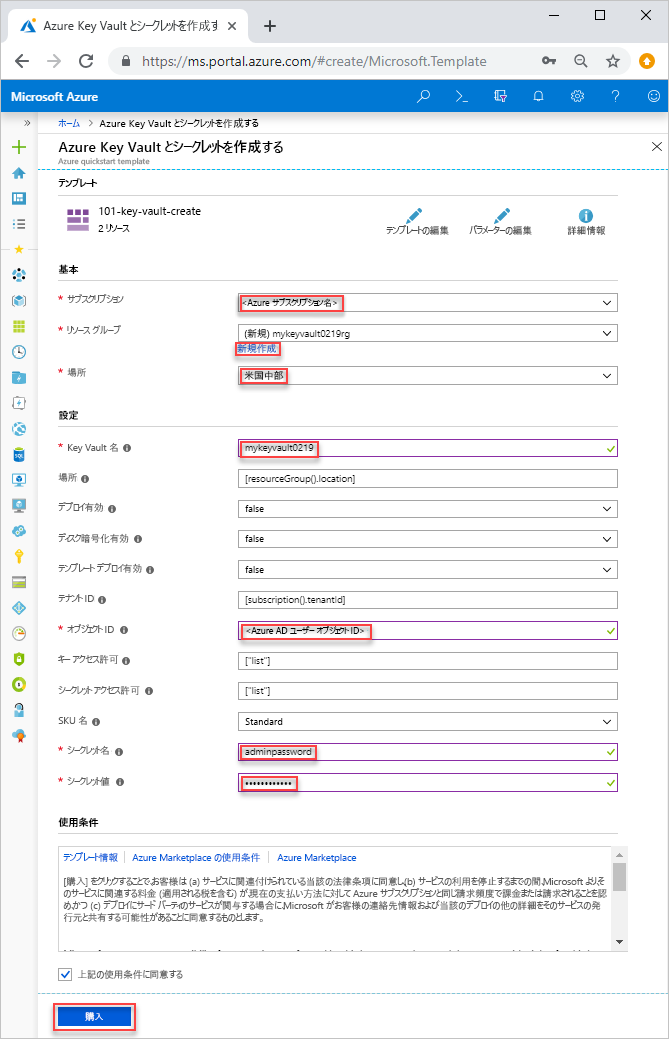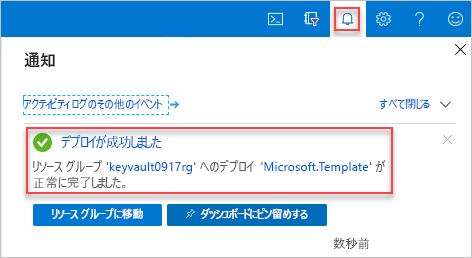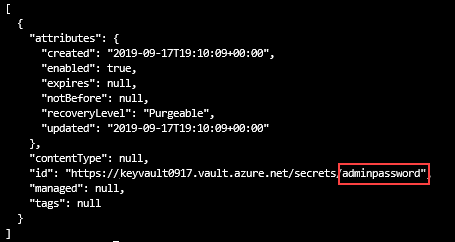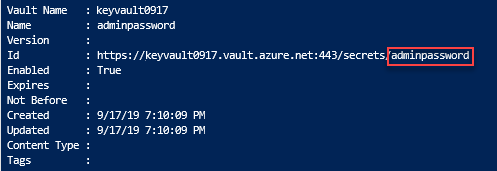クイック スタート:ARM テンプレートを使用して Azure Key Vault との間でシークレットの設定と取得を行う
Azure Key Vault は、キー、パスワード、証明書、その他のシークレットなど、シークレットのための安全な保管場所を提供するクラウド サービスです。 このクイックスタートでは、Azure Resource Manager テンプレート (ARM テンプレート) をデプロイしてキー コンテナーとシークレットを作成する過程を中心に取り上げます。
Azure Resource Manager テンプレートは JavaScript Object Notation (JSON) ファイルであり、プロジェクトのインフラストラクチャと構成が定義されています。 このテンプレートでは、宣言型の構文が使用されています。 デプロイしようとしているものを、デプロイを作成する一連のプログラミング コマンドを記述しなくても記述できます。
環境が前提条件を満たしていて、ARM テンプレートの使用に慣れている場合は、 [Azure へのデプロイ] ボタンを選択します。 Azure portal でテンプレートが開きます。
前提条件
この記事を完了するには:
Azure サブスクリプションをお持ちでない場合は、開始する前に無料アカウントを作成してください。
Microsoft Entra ユーザーオブジェクト ID は、テンプレートによるアクセス許可の設定で必要です。 次の手順を使用してオブジェクト ID (GUID) を取得します。
[使ってみる] を選択し、シェル ウィンドウにスクリプトを貼り付けて、次の Azure PowerShell または Azure CLI コマンドを実行します。 スクリプトを貼り付けるには、シェルを右クリックし、 [貼り付け] を選択します。
echo "Enter your email address that is used to sign in to Azure:" && read upn && az ad user show --id $upn --query "Id" && echo "Press [ENTER] to continue ..."オブジェクト ID を書き留めます。 このクイック スタートの次のセクションで必要になります。
テンプレートを確認する
このクイックスタートで使用されるテンプレートは Azure クイックスタート テンプレートからのものです。
{
"$schema": "https://schema.management.azure.com/schemas/2019-04-01/deploymentTemplate.json#",
"contentVersion": "1.0.0.0",
"metadata": {
"_generator": {
"name": "bicep",
"version": "0.26.54.24096",
"templateHash": "8629186205194254058"
}
},
"parameters": {
"keyVaultName": {
"type": "string",
"metadata": {
"description": "Specifies the name of the key vault."
}
},
"location": {
"type": "string",
"defaultValue": "[resourceGroup().location]",
"metadata": {
"description": "Specifies the Azure location where the key vault should be created."
}
},
"enabledForDeployment": {
"type": "bool",
"defaultValue": false,
"metadata": {
"description": "Specifies whether Azure Virtual Machines are permitted to retrieve certificates stored as secrets from the key vault."
}
},
"enabledForDiskEncryption": {
"type": "bool",
"defaultValue": false,
"metadata": {
"description": "Specifies whether Azure Disk Encryption is permitted to retrieve secrets from the vault and unwrap keys."
}
},
"enabledForTemplateDeployment": {
"type": "bool",
"defaultValue": false,
"metadata": {
"description": "Specifies whether Azure Resource Manager is permitted to retrieve secrets from the key vault."
}
},
"tenantId": {
"type": "string",
"defaultValue": "[subscription().tenantId]",
"metadata": {
"description": "Specifies the Azure Active Directory tenant ID that should be used for authenticating requests to the key vault. Get it by using Get-AzSubscription cmdlet."
}
},
"objectId": {
"type": "string",
"metadata": {
"description": "Specifies the object ID of a user, service principal or security group in the Azure Active Directory tenant for the vault. The object ID must be unique for the list of access policies. Get it by using Get-AzADUser or Get-AzADServicePrincipal cmdlets."
}
},
"keysPermissions": {
"type": "array",
"defaultValue": [
"list"
],
"metadata": {
"description": "Specifies the permissions to keys in the vault. Valid values are: all, encrypt, decrypt, wrapKey, unwrapKey, sign, verify, get, list, create, update, import, delete, backup, restore, recover, and purge."
}
},
"secretsPermissions": {
"type": "array",
"defaultValue": [
"list"
],
"metadata": {
"description": "Specifies the permissions to secrets in the vault. Valid values are: all, get, list, set, delete, backup, restore, recover, and purge."
}
},
"skuName": {
"type": "string",
"defaultValue": "standard",
"allowedValues": [
"standard",
"premium"
],
"metadata": {
"description": "Specifies whether the key vault is a standard vault or a premium vault."
}
},
"secretName": {
"type": "string",
"metadata": {
"description": "Specifies the name of the secret that you want to create."
}
},
"secretValue": {
"type": "securestring",
"metadata": {
"description": "Specifies the value of the secret that you want to create."
}
}
},
"resources": [
{
"type": "Microsoft.KeyVault/vaults",
"apiVersion": "2023-07-01",
"name": "[parameters('keyVaultName')]",
"location": "[parameters('location')]",
"properties": {
"enabledForDeployment": "[parameters('enabledForDeployment')]",
"enabledForDiskEncryption": "[parameters('enabledForDiskEncryption')]",
"enabledForTemplateDeployment": "[parameters('enabledForTemplateDeployment')]",
"tenantId": "[parameters('tenantId')]",
"enableSoftDelete": true,
"softDeleteRetentionInDays": 90,
"accessPolicies": [
{
"objectId": "[parameters('objectId')]",
"tenantId": "[parameters('tenantId')]",
"permissions": {
"keys": "[parameters('keysPermissions')]",
"secrets": "[parameters('secretsPermissions')]"
}
}
],
"sku": {
"name": "[parameters('skuName')]",
"family": "A"
},
"networkAcls": {
"defaultAction": "Allow",
"bypass": "AzureServices"
}
}
},
{
"type": "Microsoft.KeyVault/vaults/secrets",
"apiVersion": "2023-07-01",
"name": "[format('{0}/{1}', parameters('keyVaultName'), parameters('secretName'))]",
"properties": {
"value": "[parameters('secretValue')]"
},
"dependsOn": [
"[resourceId('Microsoft.KeyVault/vaults', parameters('keyVaultName'))]"
]
}
],
"outputs": {
"location": {
"type": "string",
"value": "[parameters('location')]"
},
"name": {
"type": "string",
"value": "[parameters('keyVaultName')]"
},
"resourceGroupName": {
"type": "string",
"value": "[resourceGroup().name]"
},
"resourceId": {
"type": "string",
"value": "[resourceId('Microsoft.KeyVault/vaults', parameters('keyVaultName'))]"
}
}
}
テンプレートでは、次の 2 つの Azure リソースが定義されています。
- Microsoft.KeyVault/vaults: Azure キー コンテナーが作成されます。
- Microsoft.KeyVault/vaults/secrets: キー コンテナー シークレットが作成されます。
その他の Azure Key Vault テンプレートのサンプルは、Azure クイックスタート テンプレートのページから入手できます。
テンプレートのデプロイ
Azure にサインインし、テンプレートを開くには次のイメージを選択します。 このテンプレートを使用すると、キー コンテナーとシークレットが作成されます。
次の値を選択または入力します。

指定がない場合、既定値を使用してキー コンテナーとシークレットを作成してください。
- サブスクリプション: Azure サブスクリプションを選択します。
- リソース グループ: [新規作成] を選択し、リソース グループの一意の名前を入力し、 [OK] をクリックします。
- 場所: 場所を選択します。 たとえば [米国中部] です。
- Key Vault 名: キー コンテナーの名前を入力します。この名前は、.vault.azure.net 名前空間内でグローバルに一意である必要があります。 次のセクションでデプロイを検証するときに、その名前が必要です。
- テナント ID: テンプレート関数によって自動的にテナント ID が取得されます。 既定値を変更しないでください。
- Ad ユーザー ID: 前提条件から取得した Microsoft Entra ユーザー オブジェクト ID を入力します。
- シークレット名: キー コンテナーに格納するシークレットの名前を入力します。 たとえば、adminpassword にします。
- シークレット値: シークレットの値を入力します。 パスワードを保管する場合、前提条件で作成したパスワードを使用することをお勧めします。
- 上記の使用条件に同意する: 選択。
[購入] を選択します。 キー コンテナーが正常にデプロイされると、次の通知が表示されます。

テンプレートをデプロイするには Azure portal を使用します。 Azure portal だけでなく、Azure PowerShell、Azure CLI、および REST API を使用することもできます。 他のデプロイ方法については、「テンプレートのデプロイ」を参照してください。
デプロイされているリソースを確認する
Azure portal を使用し、キー コンテナーとシークレットを確認するか、次の Azure CLI または Azure PowerShell スクリプトを使用し、作成されたシークレットを一覧表示できます。
echo "Enter your key vault name:" &&
read keyVaultName &&
az keyvault secret list --vault-name $keyVaultName &&
echo "Press [ENTER] to continue ..."
出力は次のようになります。
リソースをクリーンアップする
Key Vault に関する他のクイック スタートとチュートリアルは、このクイック スタートに基づいています。 後続のクイック スタートおよびチュートリアルを引き続き実行する場合は、これらのリソースをそのまま残しておくことをお勧めします。 不要になったら、リソース グループを削除します。これにより、Key Vault と関連リソースが削除されます。 Azure CLI または Azure PowerShell を使用してリソース グループを削除するには、次を実行します。
echo "Enter the Resource Group name:" &&
read resourceGroupName &&
az group delete --name $resourceGroupName &&
echo "Press [ENTER] to continue ..."
次のステップ
このクイックスタートでは、ARM テンプレートを使用してキー コンテナーとシークレットを作成し、デプロイを検証しました。 Key Vault と Azure Resource Manager の詳細については、引き続き以下の記事を参照してください。
- Azure Key Vault の概要を確認する
- Azure Resource Manager の詳細を確認する
- Key Vault のセキュリティの概要を確認する


